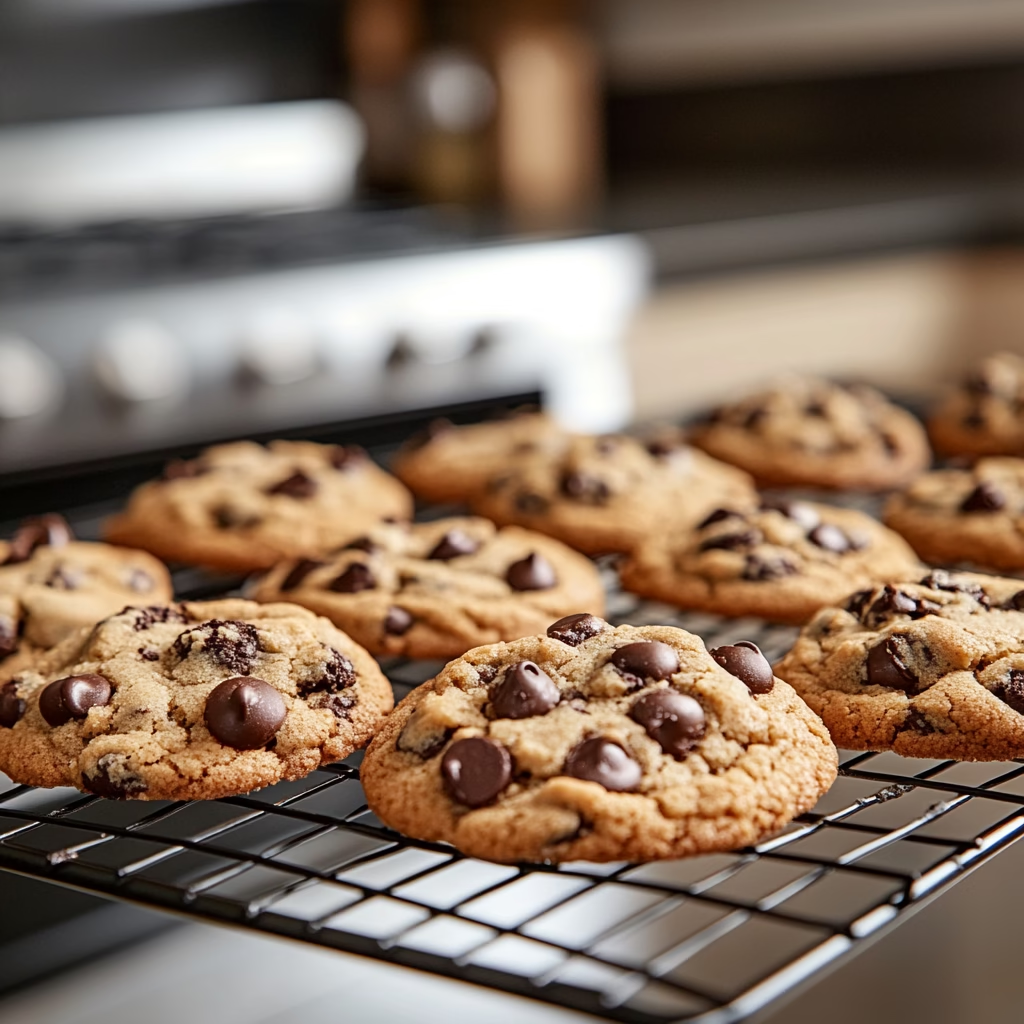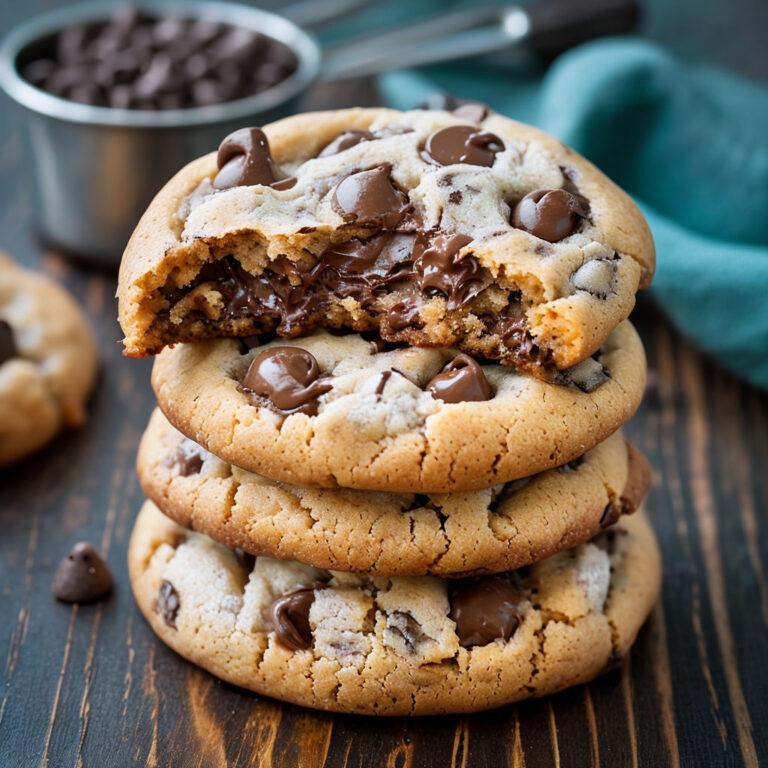Chocolate Chip Cookies: The Ultimate Guide
Chocolate chip cookies are more than just a dessert — they’re a beloved treat enjoyed by millions around the world. From their humble beginnings to the variety of recipes and techniques available today, these cookies have cemented themselves as a timeless favorite. In this guide, we’ll dive into everything you need to know about chocolate chip cookies, starting from their history and basic ingredients to baking tips and popular variations.
Introduction to Chocolate Chip Cookies
A Brief History of Chocolate Chip Cookies
The story of chocolate chip cookies begins in the 1930s in Massachusetts, USA. Ruth Wakefield, the co-owner of the Toll House Inn, is credited with their invention. As the legend goes, Ruth was experimenting with a butter cookie recipe when she decided to add chunks of Nestlé semi-sweet chocolate, expecting them to melt into the batter. Instead, the chocolate held its shape, creating the first batch of what we now know as chocolate chip cookies.
This accidental discovery quickly gained popularity, and by the late 1930s, Nestlé began printing the recipe on their chocolate packaging. Over time, chocolate chip cookies became a staple in American households and eventually spread worldwide.
Why Chocolate Chip Cookies Are So Popular
- Universality: Chocolate chip cookies are easy to make, and their ingredients are readily available.
- Versatility: They can be soft, chewy, crispy, or gooey, depending on your preference.
- Comfort Food Appeal: These cookies evoke a sense of nostalgia and comfort for many people.

The Origin Story
Who Invented Chocolate Chip Cookies?
As mentioned, Ruth Wakefield is the genius behind this culinary marvel. Her creation was so impactful that Nestlé purchased the rights to her recipe in exchange for a lifetime supply of chocolate.
The Role of Ruth Wakefield
Ruth’s contribution to baking culture didn’t stop with cookies. She was also a skilled cookbook author and an innovator in the kitchen. Her original recipe, known as the « Toll House Chocolate Crunch Cookie, » remains a foundation for countless adaptations today.
The Key Ingredients
Chocolate Chips: Types and Varieties
When making chocolate chip cookies, the type of chocolate you use plays a significant role in the final taste and texture. Here are some popular options:
- Milk Chocolate Chips: Sweeter and creamier, these are ideal for those who prefer a milder chocolate flavor.
- Dark Chocolate Chips: Rich and slightly bitter, perfect for balancing out the sweetness of the dough.
- Semi-Sweet Chips: A classic choice for traditional recipes.
- White Chocolate Chips: A great alternative for a unique twist.
- Carob Chips: A non-chocolate option often used in vegan or allergen-friendly recipes.
Essential Pantry Staples
To bake the perfect chocolate chip cookies, you’ll need these basic ingredients:
- Flour: Provides structure to the cookies.
- Sugar: A mix of granulated and brown sugar creates the ideal balance of sweetness and chewiness.
- Butter: Adds richness and helps achieve a soft texture.
- Eggs: Bind the ingredients and add moisture.
- Baking Soda: Ensures the cookies rise properly.
- Vanilla Extract: Enhances the flavor.
Different Types of Chocolate Chips
Choosing the right type of chocolate chip can elevate your baking experience:
- Milk Chocolate: Best for soft and sweet cookies.
- Dark or Bittersweet Chocolate: Adds depth and complexity.
- White Chocolate: A sweeter alternative that pairs well with mix-ins like cranberries or macadamia nuts.
- Carob Chips: Great for those avoiding caffeine or traditional chocolate.
Experimenting with a combination of these can help you find your perfect flavor profile.
Baking Basics
The Science of Baking Cookies
Baking is both an art and a science. Understanding the role of each ingredient and how they interact is key to achieving perfect cookies:
- Butter: Using room-temperature butter helps create a smooth and creamy dough.
- Sugars: Brown sugar adds moisture, while granulated sugar contributes to crisp edges.
- Eggs: Overbeating eggs can lead to tougher cookies, so mix just until combined.
How Temperature Affects Texture
Baking temperature and time directly influence the texture of your cookies:
- Lower temperatures (around 325°F): Result in soft, gooey cookies.
- Higher temperatures (375°F and above): Create crispier edges with a chewy center.
Equipment Essentials
Must-Have Tools for Perfect Cookies
Having the right tools can make the baking process easier and more efficient:
- Mixing Bowls: For combining wet and dry ingredients.
- Silicone Mats or Parchment Paper: Prevent cookies from sticking and ensure even baking.
- Cookie Scoops: Help achieve uniform sizes, resulting in evenly baked cookies.
- Cooling Racks: Allow cookies to cool evenly and prevent overcooking.
Silicone Mats vs. Parchment Paper
Both options are effective, but silicone mats are reusable and provide consistent results. Parchment paper is a great disposable alternative for easy cleanup.
Measuring Ingredients Correctly
Why Precision Matters in Baking
Baking is not the time to « eyeball » measurements. Small inaccuracies can significantly alter the texture and taste of your cookies. For example:
- Too much flour: Leads to dry, crumbly cookies.
- Not enough sugar: Results in bland, less caramelized cookies.
Tools for Accurate Measurements
Invest in quality tools like:
- Measuring cups and spoons.
- A digital kitchen scale for precise weight measurements.
- A liquid measuring cup for wet ingredients.
Prepping Your Workspace
Organizing Your Kitchen for Efficient Baking
Before you start baking, ensure your kitchen is well-prepped:
- Gather all ingredients and tools in one place.
- Preheat your oven to the correct temperature.
- Line your baking sheets and set up cooling racks in advance.
Classic vs. Modern Recipes
How the Recipe Has Evolved Over the Years
While the original Toll House recipe remains a classic, bakers today enjoy experimenting with:
- Alternative flours (e.g., almond or coconut flour).
- Health-conscious substitutions like coconut sugar or avocado oil.
- Fun mix-ins like candy pieces, pretzels, or marshmallows.
Popular Variations of the Recipe
Vegan, Gluten-Free, and Keto Versions
Baking for dietary restrictions has become easier with ingredient swaps:
- Vegan: Replace butter with plant-based alternatives and eggs with flaxseed or applesauce.
- Gluten-Free: Use almond, oat, or gluten-free all-purpose flour.
- Keto: Substitute sugar with erythritol and use almond flour.
Adding Mix-Ins Like Nuts or Candies
Enhance your cookies with extra flavors and textures by mixing in:
- Chopped nuts like walnuts or pecans.
- Dried fruits such as cranberries or cherries.
- Candies like M&Ms or toffee bits.
Step-by-Step Guide to Making Chocolate Chip Cookies
Making chocolate chip cookies is a delightful process that combines simple techniques with delicious results. This section will walk you through the steps to achieve cookie perfection, from preparing the dough to storing leftovers.
Preparing the Dough
Combining Dry and Wet Ingredients
The first step in making cookie dough is to prepare the dry and wet components separately:
- Dry Ingredients: Mix flour, baking soda, and salt in a separate bowl. This ensures even distribution of leavening agents.
- Wet Ingredients: Cream butter and sugars together until light and fluffy. This step aerates the mixture, helping the cookies rise.
Once both mixtures are ready:
- Gradually add the dry ingredients to the wet ingredients.
- Mix until just combined to avoid overdeveloping the gluten, which can make cookies tough.
Tips for Creaming Butter and Sugar
- Use room-temperature butter for easier mixing.
- Beat the butter and sugar for at least 2-3 minutes to achieve a light texture.
- Avoid over-creaming, as this can cause cookies to spread too much during baking.
Perfecting the Consistency
Achieving the Right Dough Texture
The dough should be soft and pliable but not sticky. If it feels:
- Too dry: Add a teaspoon of milk or water to hydrate.
- Too wet: Incorporate a tablespoon of flour at a time until the desired consistency is achieved.
Adjusting Dough Based on Altitude
Baking at higher altitudes requires slight adjustments:
- Reduce sugar slightly to prevent cookies from spreading.
- Add a tablespoon of flour to maintain structure.
Adding the Chocolate Chips
How to Fold Chips Evenly Into the Dough
- Use a rubber spatula to gently fold the chocolate chips into the dough.
- Avoid overmixing, as this can break the chips and distribute them unevenly.
Tips for Customized Chip Ratios
- Prefer more chocolate? Add an extra ¼ cup of chips.
- Love a balanced bite? Use a mix of milk, dark, and semi-sweet chips for variety.
Preheating the Oven
Why Preheating is Crucial
Preheating ensures the oven reaches the desired temperature before you place your cookies inside. Baking in an under-heated oven can lead to:
- Uneven cooking.
- Spreading dough that doesn’t hold its shape.
Recommended Temperatures for Even Baking
- 350°F (175°C): For soft and chewy cookies.
- 375°F (190°C): For crispier edges with a gooey center.
Shaping the Cookies
Using a Cookie Scoop vs. Freehand
- Cookie Scoop: Ensures uniform sizes, resulting in evenly baked cookies.
- Freehand: Offers a rustic look but may require more attention to baking times.
Achieving Uniform Sizes for Consistent Baking
- Roll the dough into balls of similar size.
- Place them 2 inches apart on the baking sheet to allow room for spreading.
Baking to Perfection
Determining the Ideal Baking Time
- Start checking cookies around the 8-minute mark.
- They are done when the edges are golden brown, but the centers still look slightly undercooked.
Tricks to Avoid Overbaking
- Remove cookies from the oven when they look slightly soft in the center; they will continue cooking on the hot baking sheet.
- Use parchment paper or silicone mats to prevent over-browning.
Cooling the Cookies
Properly Transferring Cookies to a Cooling Rack
- Let cookies sit on the baking sheet for 2-3 minutes to firm up.
- Transfer them to a cooling rack to avoid sogginess from trapped steam.
Why Cooling Affects Texture
Allowing cookies to cool helps them set properly, resulting in a chewy or crispy texture depending on your preference.
Common Mistakes to Avoid
Overmixing Dough
Overmixing incorporates too much air, leading to flat, dense cookies. Mix just until ingredients are combined.
Incorrect Oven Temperatures
An oven thermometer can help ensure accuracy, as many ovens run hotter or cooler than their settings.
Testing for Doneness
Visual Cues for Perfectly Baked Cookies
- Edges should be golden brown.
- Centers should appear slightly soft but not wet.
Using a Toothpick for Testing
While not common for cookies, a toothpick can confirm doneness if you’re unsure. Insert it into the center; it should come out with moist crumbs but not raw dough.
Storing the Dough
How to Freeze Cookie Dough for Later
Freezing dough is a great way to enjoy fresh cookies whenever you want:
- Shape the dough into balls and freeze them on a baking sheet until firm.
- Transfer to a freezer bag, removing excess air.
Defrosting Tips
- Bake frozen dough directly, adding 1-2 minutes to the baking time.
- For best results, let the dough thaw for 10-15 minutes before baking.
Troubleshooting Guide
Here’s a quick reference for common baking issues:
- Flat Cookies: Chill the dough before baking and ensure your baking soda is fresh.
- Dry Cookies: Use the correct balance of sugar and fat, and avoid overbaking.
- Uneven Cookies: Use a cookie scoop for consistent sizing and even baking.
Bonus Tips for Perfect Cookies
- Sprinkle a pinch of sea salt on top of the dough balls before baking for a gourmet touch.
- Chill the dough for at least 30 minutes to enhance flavor and prevent excessive spreading.
- Experiment with different add-ins like toffee bits, coconut flakes, or even potato chips for a unique twist.
Advanced Techniques, Pairings, and Fun Facts About Chocolate Chip Cookies
Now that we’ve covered the basics and step-by-step instructions for making the perfect chocolate chip cookies, let’s dive into advanced baking techniques, creative pairings, and some fascinating facts that will deepen your appreciation for this timeless treat.

Advanced Baking Techniques
Using Brown Butter for Extra Flavor
If you want to elevate your cookies, try using brown butter. This simple technique adds a rich, nutty flavor that enhances the overall cookie profile.
How to Make Brown Butter:
- Heat unsalted butter in a saucepan over medium heat.
- Stir constantly until the butter turns golden brown and gives off a nutty aroma.
- Let it cool slightly before incorporating it into the dough.
Why It Works: The browning process caramelizes the milk solids in the butter, adding depth and complexity to your cookies.
Link: Bon Appétit
Sentence: « Dive deeper into advanced baking techniques with expert advice from Bon Appétit. »
Using Sea Salt as a Topping
A sprinkle of flaky sea salt on top of the dough before baking can enhance the flavor contrast between sweet and savory. The salt crystals also provide a subtle crunch that makes each bite more interesting.
Pro Tip: Use Maldon or Himalayan pink salt for the best results.
Experimenting with Flavors
Adding Spices Like Cinnamon or Cardamom
Spices can transform your chocolate chip cookies into something extraordinary. Try adding:
- Cinnamon: For a warm, cozy flavor.
- Cardamom: To introduce a hint of floral and citrus notes.
- Nutmeg or Clove: Perfect for holiday-inspired cookies.
Using Flavored Extracts
Instead of plain vanilla extract, experiment with:
- Almond extract for a nutty twist.
- Coconut extract for tropical vibes.
- Mint extract for a refreshing touch.
Pairing Cookies with Beverages
Best Coffee Blends to Enjoy with Cookies
Coffee and cookies are a match made in heaven. Here’s what pairs best:
- Dark Roast: Complements the sweetness of the cookies with its robust flavor.
- Medium Roast with Chocolate Notes: Enhances the chocolate in the cookies.
- Espresso: A shot of espresso balances the richness of gooey cookies.
Kid-Friendly Milk Options
- Whole milk is a classic choice for dunking cookies.
- Oat milk adds a creamy, slightly nutty flavor.
- Chocolate milk doubles down on the indulgence factor.
More FAQs
- What’s the best flour for chocolate chip cookies?
All-purpose flour is traditional, but experimenting with almond or whole wheat flour can add variety. - Can I make cookies without eggs?
Yes! Substitute eggs with flaxseed meal, applesauce, or aquafaba. - Why do cookies spread too much?
Dough that’s too warm or has too much butter can cause spreading. Chilling the dough helps. - What’s the secret to chewy cookies?
Use more brown sugar than granulated sugar, and don’t overbake. - How do I store baked cookies?
Store them in an airtight container at room temperature for up to a week. - Can I freeze cookie dough?
Absolutely! Frozen cookie dough can last up to 3 months. - How do I make cookies crispier?
Use more granulated sugar and bake at a slightly higher temperature. - Can I use margarine instead of butter?
Yes, but the flavor and texture may differ slightly. - What’s the best chocolate-to-dough ratio?
A 1:3 ratio (1 cup of chips for every 3 cups of dough) is ideal, but feel free to adjust to your preference. - Why do cookies taste better the next day?
Resting the dough allows the flavors to meld, resulting in a richer taste.

